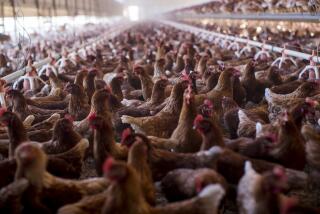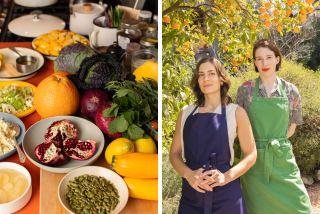Getting to the Meat of the Vegetarian Issue
Personally, I’ve got nothing against vegetarians. Some--no, many--are quite nice. I know this because my daughter was one--briefly--actually just long enough to turn up her nose at my crown roast of pork at a family Christmas dinner. But, as I said, many are nice.
They are also hard to cook for. This is a blanket statement, of course, and a dangerous one. Vegetarians who’ve been to dinner at my house range from people who eat no meat but do eat poultry and fish to those who, in the memorable phrase, “don’t eat anything that had a face.”
Some vegetarians go further and don’t eat anything that comes from something with a face--meaning no eggs, no milk, no cheese. I have no interest in sharing a table with someone who doesn’t love cheese.
To a certain point, of course, everyone’s diet is his or her own private business. I would no more criticize someone for abstaining from meat than I would expect him to criticize me for relishing it. But as a practical matter, I have a hard time building a menu without meat.
That’s because we’ve been trained to think of a meal as having a center, and in our culture that center is usually a big piece of meat or a similar dish. I can hardly think of a dinner table without thinking about the roast chicken that’s on it.
Composing a meal without that kind of center feels wrong to me, like telling a story with no point. No matter how many dishes you fix, they feel like they’re floating in some kind of random universe, without the gravitational pull of a sun to bring order. It’s not a meal, it’s a bunch of side dishes in search of a menu.
This is narrow-minded of me and probably culturally insensitive to boot. Fine. Don’t eat dinner at my house. Or at least don’t expect me to cook for you.
That’s easy enough to say, but I could never draw such a hard line in real life. We have vegetarians to dinner quite regularly (Some of My Best Friends. . . .) But that brings us back to the initial question: What do you cook for them?
Even with plenty of vegetarian cookbooks out there, it’s hard to find a recipe for something that has the culinary gravity required to hold a meal together. Specific gravity, maybe, but that’s not the same thing. Because you eat brown rice-nut loaf at your house doesn’t mean you’ll be eating it at mine. Especially not if I have to eat it too.
*
One solution I’ve found is vegetable lasagnas. They seem to work where other pasta dishes don’t--maybe because all that cheese makes them feel more substantial, maybe for no other reason than that they take just enough work to put together that they ought to be a main dish. Whatever the reason, a lasagna works for me where something like fresh pasta tossed with vegetables and tomato sauce might not.
By the way, fresh pasta makes a huge difference in lasagna. Instead of being a bookmark dividing the layers, a fresh noodle is the light, silky soul of the dish.
And don’t all those nice vegetarian people deserve a little something extra?
BROCCOLI LASAGNA
Broccoli rabe (also called rapini or broccoli rape) is a relative of broccoli that is popular in Italy and is catching on in this country. It has a spicy taste with a slightly bitter edge that makes it a nice counterpoint to the richness of the cheese. If you can’t find broccoli rabe, use 1 1/2 pounds of broccoli.
PASTA DOUGH
1 1/2 cups flour
1/2 teaspoon salt
1 tablespoon olive oil
2 eggs
Water
In bowl of food processor fitted with steel blade, combine flour, salt and olive oil. Pulse once or twice to combine. Add eggs and process until dough forms rough ball that holds together, about 20 seconds. If necessary, slowly add up to 1 tablespoon water. Continue processing 10 to 15 seconds to knead. Wrap dough tightly in plastic wrap and set aside to rest for 30 minutes.
Cut dough in half; cover half with damp tea towel. Flatten remaining half by hand, then dust lightly with flour and pass through widest setting on pasta machine. Fold double, dust and roll again. Repeat until dough becomes silky to touch, 7 or 8 passes.
When dough is correct texture, roll out in pasta machine in ever-narrowing widths as thin as you can without tearing noodles. Hang noodles to dry and repeat with remaining dough.
SPICY TOMATO SAUCE
2 tablespoons olive oil
1 onion, minced
4 cloves garlic, minced
1 (28-ounce) can tomatoes
1 teaspoon red chile flakes
Salt, black pepper
In medium saucepan, heat oil, add onion and garlic and cook over medium-low heat until translucent, about 10 minutes. Add tomatoes and red pepper flakes and cook until tomatoes begin to fall apart, about 5 minutes.
Puree sauce through food mill into another saucepan. Cook sauce over medium heat until smooth and combined, about 10 minutes. Season to taste with salt and pepper.
BROCCOLI FILLING
1 pound broccoli
1/2 pound broccoli rabe
1 (15-ounce) package ricotta
1/2 pound fresh goat cheese
1 tablespoon grated pecorino Romano
Salt
1 tablespoon minced parsley
Separate and reserve florets from broccoli stalks. Peel broccoli stalks, trim ends and cut in small cubes. Separate and reserve leaves from broccoli rabe and cut stems in small cubes.
Cook broccoli and broccoli rabe stems in plenty of rapidly boiling, salted water until tender-crisp, about 5 to 7 minutes. Remove from water and drain. Add florets and leaves to boiling water and cook until tender, about 2 to 3 minutes. Remove and drain. Chop leaves and florets in rough pieces.
In bowl, combine broccoli and broccoli rabe stems, leaves and florets, ricotta, goat cheese and Romano cheese. Mix well and add salt to taste. Romano is salty, so be cautious.
To assemble: Cook lasagna noodles 2 pieces at a time in plenty of rapidly boiling salted water. Noodles will float to top of water when cooked, about 1 to 2 minutes.
Spread 1/2 cup tomato sauce in bottom of lightly oiled 13x9-inch glass baking dish. Place 1 layer of noodles over sauce. Top with 1/4 of broccoli mixture and spread evenly over noodles. Repeat, alternating noodles and broccoli mixture until all broccoli mixture is used, ending with layer of noodles. Compress and smooth filling by pressing lightly on top layer with palm of hand.
Spread remaining tomato sauce over top of lasagna and bake at 350 degrees until heated through, about 20 to 30 minutes. Before serving, sprinkle minced parsley over top of lasagna.
Makes 6 to 8 servings.
Each of 6 servings contains about:
485 calories; 776 mg sodium; 125 mg cholesterol; 27 grams fat; 38 grams carbohydrates; 25 grams protein; 2.14 grams fiber.
More to Read
Eat your way across L.A.
Get our weekly Tasting Notes newsletter for reviews, news and more.
You may occasionally receive promotional content from the Los Angeles Times.










